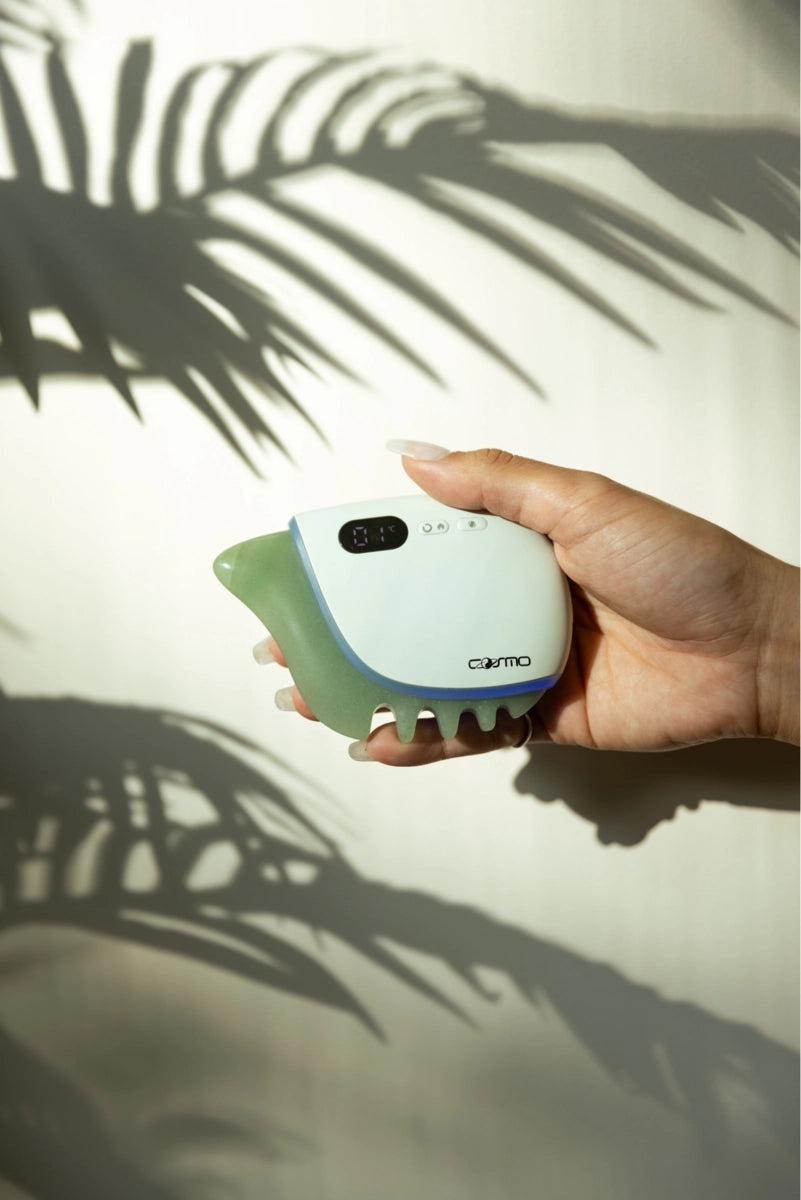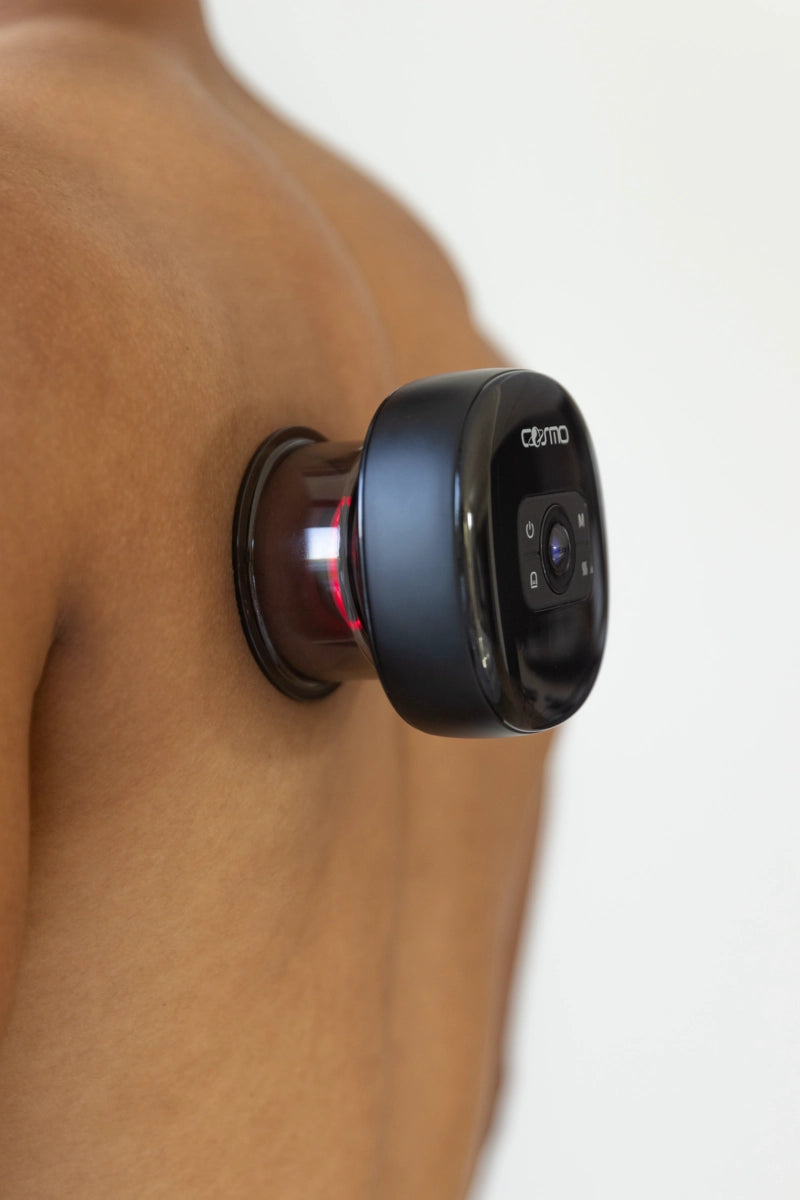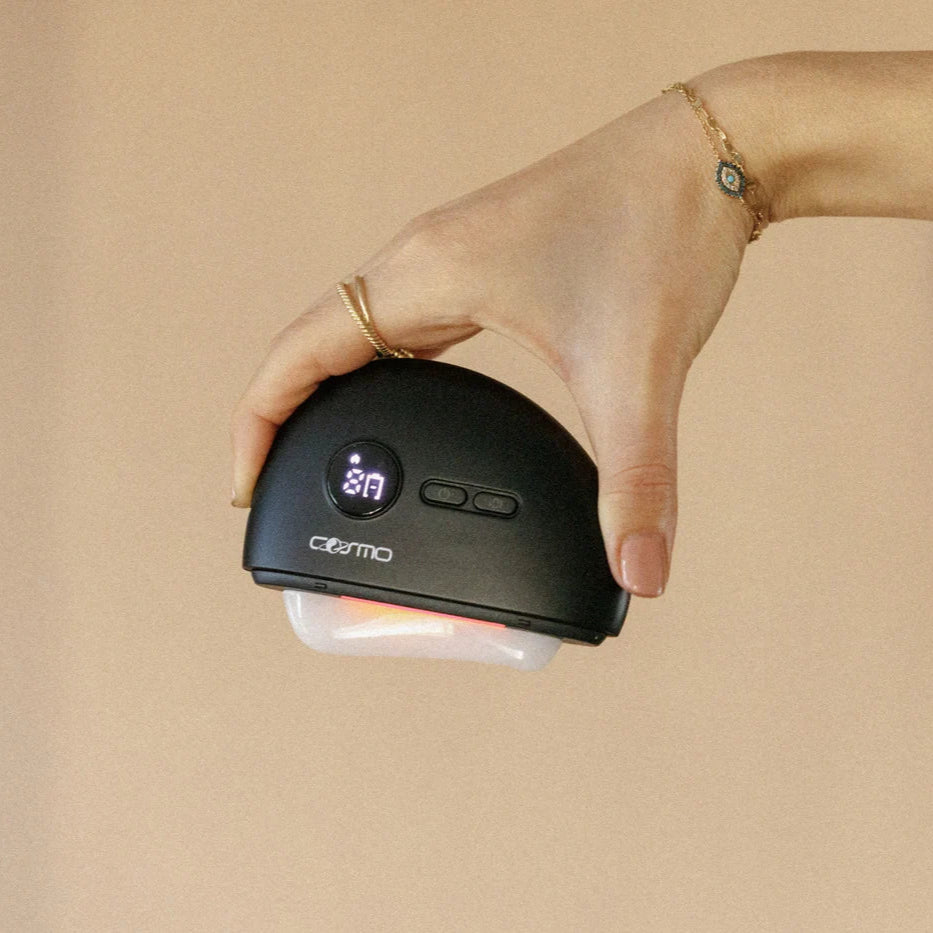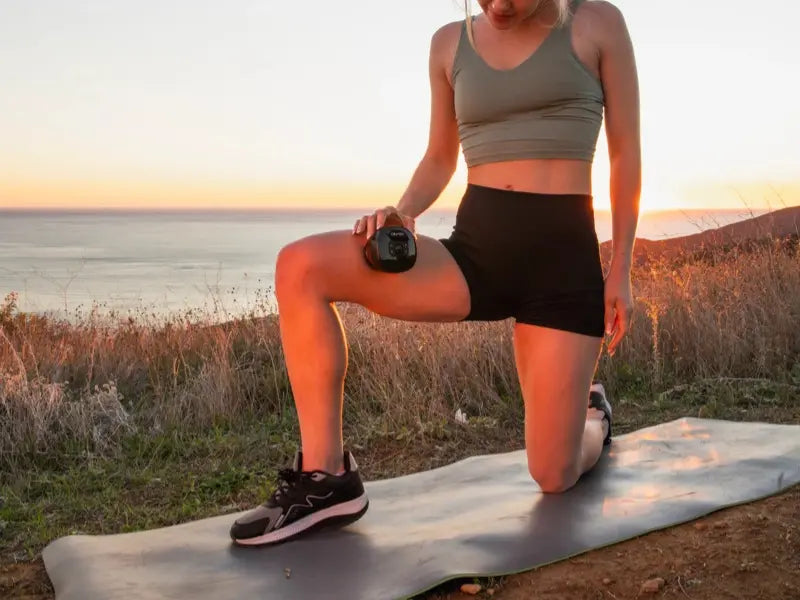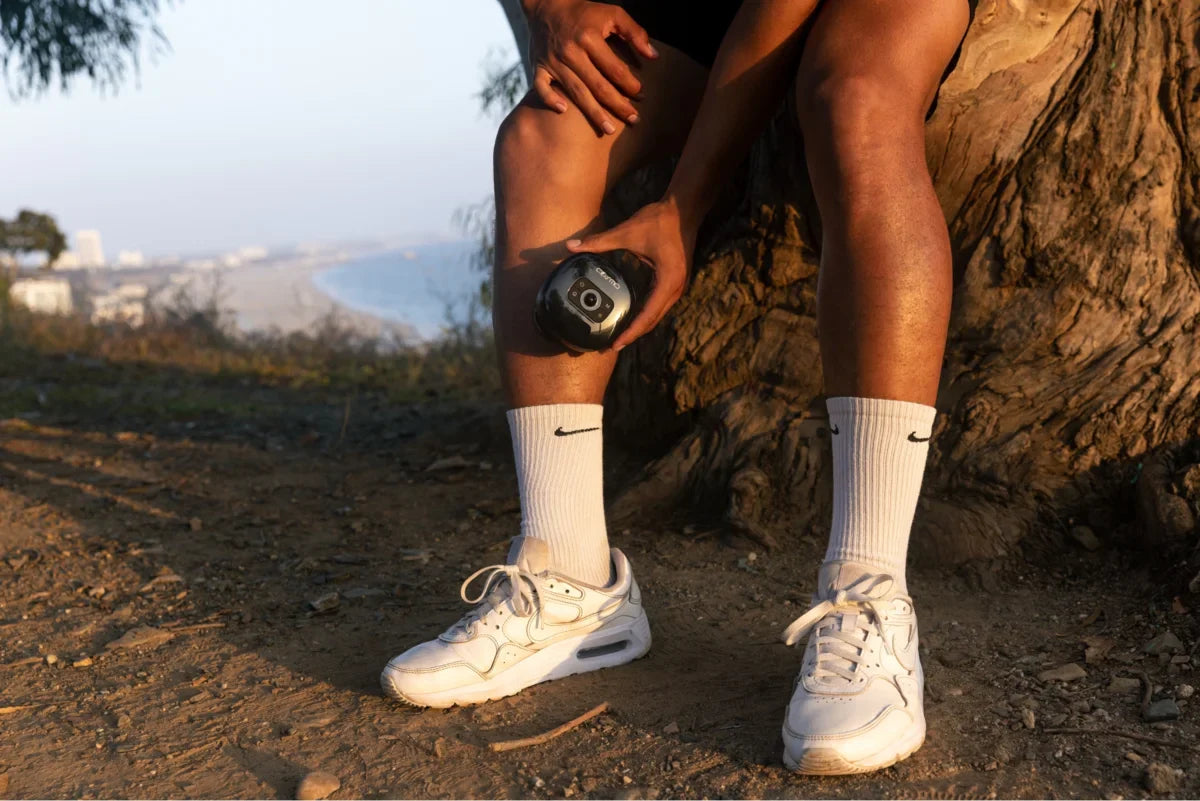Have you ever noticed a stiff neck suddenly ease up after stretching your back, or a knee pain improve when you roll out your foot? These seemingly unrelated aches can actually be connected along continuous tissue pathways in the body. Modern anatomy shows that tension in one area can travel through the body's web of connective tissue and affect distant regions. These continuous pathways of connective tissue are known as myofascial meridians, often referred to as fascia lines, and they offer a fascinating explanation for how different parts of our body interlink. Even more intriguing is how this modern concept mirrors ancient wellness knowledge – the meridian lines of Traditional Chinese Medicine – suggesting a deep connection between our physical structure and the flow of energy within.
In this article, we'll explore what myofascial meridian lines are and how they function, bridging the gap between anatomy and traditional meridian theory. You'll learn how the body’s connective tissue network plays a crucial role in posture, movement, and possibly even the flow of vitality or "Qi." We'll also discuss how maintaining healthy fascia through lifestyle practices can improve your well-being. From understanding the science behind these fascial chain pathways to practical self-care tips (like foam rolling or Gua Sha), this exploration is a journey through the inner connective landscape of the body. Let’s dive into the world of fascia, meridians, and holistic wellness.
Understanding Fascia: The Body’s Connective Tissue Network
To grasp myofascial meridians, we first need to understand fascia itself. Fascia is a form of connective tissue that permeates the entire body. Imagine a three-dimensional web or sheath that wraps around and through every muscle, bone, organ, nerve, and blood vessel. If all your other tissues were somehow removed, this fibrous web would still hold your body’s shape. Fascia provides structural support and also enables communication throughout the body by connecting every part to every other part. In other words, it is a body-wide connective tissue network that binds us together from head to toe in one continuous system.
Unlike a static packing material, fascia is dynamic and responsive. It consists primarily of collagen fibers (which give it tensile strength) along with elastin (for elasticity) and a gel-like ground substance that allows glide between layers. Healthy fascia is supple and well-hydrated, allowing muscles and organs to move freely against each other. However, injury, chronic tension, or inactivity can cause fascia to become tight or stuck (often forming adhesions or "knots"). Because fascia is continuous, a restriction in one area can transmit strain elsewhere – which is why a scar on your abdomen, for example, might contribute to shoulder or back stiffness. This whole-body connectivity is what gives fascia a pivotal role in our movement and posture. It also sets the stage for understanding the special lines or meridians within this network that align with patterns of tension and force through the body.
What Are Myofascial Meridians?
So, what exactly are myofascial meridian lines? In simple terms, they are maps of the long chains of fascia that link distant muscles and regions into functional units. Pioneers in fascia research, like anatomist Thomas Myers, discovered that muscles are not isolated actors but are connected by sheets and bands of fascia that run in predictable tracks.
Myofascial meridians refer to these continuous bands of fascial tissue spanning across and throughout the body. Essentially, a myofascial meridian is an anatomical linkage where muscles and fascia join end-to-end, creating a line of pull or tension that can transmit force and movement. This concept is sometimes also described with terms like “fascial lines,” “anatomy trains,” or “fascial chains” – all referring to the same idea of connectivity through fascia.
Thomas Myers popularized the concept in his book Anatomy Trains, where he identified a myofascial meridian map of the body. Myers charted about 12 major meridian lines (such as the Superficial Back Line, Superficial Front Line, Spiral Line, and others) that run longitudinally or spirally through the body, connecting muscle groups across multiple joints. For example, one meridian line called the Superficial Back Line runs from the sole of your foot, up the back of your legs, along your spine, and over your head to your forehead. This helps explain why tight plantar fascia under your foot might relate to hamstring tension or even neck pain – they are all part of one continuous fascial pathway. Other lines cover the front of the body, sides, spirals, and arms, collectively providing a holistic view of how movement and stability are managed by fascia. The myofascial meridians concept has been broadly embraced by bodyworkers, physical therapists, and movement specialists because it provides a more integrative understanding of how the body compensates and coordinates as a whole.
These meridian lines aren’t hard, cord-like structures – think of them more like highways of connected tissue. Along each line, if one segment is pulled taut or restricted, it can affect the entire route. This is why addressing a problem in one part of a line (through stretching, massage, etc.) can often produce relief or changes in a seemingly distant area. In short, myofascial meridians give us a map for these whole-body connections, allowing practitioners to trace pain or dysfunction in one spot to its root cause along a fascial line. It’s a perspective that moves beyond viewing muscles in isolation and instead looks at the body as an interconnected web.
Metastudy and Evidence Review
To understand how well the concept of myofascial meridians stands up to scientific scrutiny, it’s important to look at how researchers have systematically reviewed the available evidence. A metastudy—also known as a systematic review—analyzes and synthesizes findings from many individual studies to provide a clearer picture of what the overall body of research shows.
In recent years, a notable systematic review was conducted to evaluate the anatomical basis for myofascial meridians. Researchers searched scientific databases for peer-reviewed anatomical dissection studies published from 1900 through 2014. Their aim was to identify whether there was documented continuity between muscles along the proposed meridian lines. To ensure objectivity, two independent investigators reviewed thousands of articles and assessed the methodological quality of each study, only including those that met strict criteria for relevance and rigor.
Out of more than 6,500 articles initially identified, only 62 studies met the inclusion standards for this comprehensive review. Each study was examined for evidence of myofascial continuity—specifically, whether the connective tissue pathways described as meridians could be observed and verified in human anatomy. The findings from these studies were then classified to reflect the overall level of evidence, helping to clarify where the scientific consensus is strong, moderate, or lacking.
This metastudy approach provides a valuable overview of the current state of research on myofascial meridians. By pooling results from decades of anatomical investigation, it offers a more balanced and reliable assessment than any single study could. For readers and practitioners alike, understanding this process is key to appreciating both the promise and the limitations of the myofascial meridian concept.
Fascial Chain Pathways and Posture
Our bodies are held together and move efficiently thanks to these fascial chain pathways. Each myofascial meridian acts like a cable, distributing tension and maintaining balance through a sequence of muscles and connective tissue. One of the key meridian line functions in the myofascial system is to transmit force and stabilize posture across the entire body. In fact, the
fascia lines play a huge role in how we stand and move. They create stability, transmit power, and also provide flexibility by allowing one part of the body to compensate for another. Research into fascia has shown that these lines provide structural support: they offer resistance and elasticity and, above all, enable what is called “compensatory posture” – adjustments our body makes to keep balance and alignment. In simpler terms, if one area is tight or weak, the fascial line helps redistribute strain so we don’t immediately fall apart; instead, another part of the line might pick up the slack, for better or worse.
This inherent balance is why fascia and posture are so closely linked. For example, consider someone who sits all day and develops tight hip flexors (the muscles at the front of the hips). That tightness doesn’t just stay local – through the anterior fascial line it can pull the pelvis forward, which in turn might cause an arch in the lower back and the head to poke forward. The entire posture adjusts around one area of tension. Over time, this could lead to discomfort in the neck or lower back because the strain has shifted along the line. On the flip side, improving the mobility of one segment of a fascial line can positively affect posture elsewhere. If you release tension in your calves and hamstrings (part of the Superficial Back Line), you might find that your lower back feels looser and you stand up taller, because the whole line has more slack.
In practice, movement therapists use knowledge of these chains to address root causes of pain. Rather than just treating the symptom (say, a sore shoulder), they might assess the entire lateral line or spiral line to find where the real imbalance is. It could be that a restriction in the opposite hip is traveling through a fascial connection and manifesting as shoulder pain. By working along the chain – stretching, massaging, or strengthening the linked tissues – they help the body return to better alignment. Thus, our posture and even our risk of injury depend on the integrity of these fascial meridians. Good posture isn’t just about strong muscles; it’s about harmonious tension in the fascial web. When everything in the web works in sync, we move with fluidity and balanced ease. But if one segment of a chain is disturbed, the whole network feels it. Understanding these pathways gives us powerful insight into why holistic approaches (like yoga or whole-body stretching routines) often improve posture more effectively than focusing on one muscle at a time.
Mapping Fascia to Traditional Meridians
Western scientists and therapists aren’t the first to map lines through the body – Eastern healing traditions did so millennia ago. A remarkable aspect of myofascial meridians is how closely they echo the meridian lines of Traditional Chinese Medicine (TCM). In TCM, meridians are the channels through which life energy (Qi) flows. There are 12 primary meridians identified in acupuncture, each connecting to specific organs and spanning the body in defined pathways. Fascinatingly, the 12 myofascial meridian lines identified by modern anatomy align closely with these 12 classical meridians. It’s as if ancient practitioners mapped out an energetic network that mirrors the physical connective tissue network discovered by anatomists like Myers. This convergence of ancient wisdom and modern science has spurred a lot of excitement in the wellness and medical communities.
Researchers have been literally mapping fascia to traditional meridians to see how much the two systems overlap. The findings so far are striking. In one review of anatomical and clinical evidence, scientists concluded that the
body’s fascia network may indeed be the physical substrate of the acupuncture meridians described in TCM. In other words, those invisible energy channels might correspond to actual connective tissue pathways. For instance, imaging studies have shown that certain acupuncture points (spots on a meridian) often lie in areas of fascia that have more nerve and blood vessel density or are at junctures of fascial planes. Additionally, when you trace the route of, say, the Kidney meridian in Chinese medicine, it runs along a path that modern anatomy would recognize as a chain of muscles and fascia from the foot up the inner leg – very similar to Myers’ Deep Front Line. Such correspondences suggest that ancient healers were observing real physiological patterns, albeit described in their own terms.

From a meridian anatomy perspective, this East-West linkage is profound. It provides a potential anatomical explanation for how acupuncture or acupressure works: by stimulating points in the fascia that affect tension and communication along a myofascial meridian, thereby influencing distant organs or areas. It also enriches the way we think about the fascial lines – not only as mechanical transmitters of force, but possibly as conduits of bioelectrical signals and fluid flow that relate to what TCM calls energy. Some scholars have proposed that meridians might correspond to the pathways of lower resistance in the body’s electrical conductivity or to channels in the embryological development that get “traced” by fascia. While research is ongoing, the strong overlap between the ancient meridian maps and modern myofascial maps provides independent validation for both. It suggests that what Eastern medicine described as Qi flowing in meridians could be, in part, the feeling of our connective tissue network conducting subtle signals and coordinating bodily functions. This bridging of knowledge encourages a holistic approach to health: understanding that working on the physical fascia (through massage, stretching, etc.) might influence one’s internal energy flow, and conversely, that practices aimed at balancing energy (like acupuncture or Tai Chi) very likely have anatomical effects on fascia.
The Role of Connective Tissue in Energy Flow
In recent years, the
role of connective tissue in energy flow has become a topic of keen interest, uniting insights from biophysics, physiology, and traditional healing. Traditional Chinese Medicine long ago asserted that a vital energy (Qi) circulates through meridian channels, influencing health and vitality. Now, modern science is exploring how fascia – with its conductive, continuous properties – might serve as the medium for this flow. One key discovery is that fascia is richly innervated and highly responsive to mechanical stimuli. When fascia is stretched or pressure is applied, it exhibits a property called piezoelectricity – meaning it generates tiny electrical currents. This occurs because collagen (the main component of fascia) is piezoelectric, so mechanical deformation produces an electric charge. What could such currents do? They might facilitate communication within the body, signaling cells to respond, or even correspond to the movement of Qi as described in acupuncture. In fact, emerging research suggests that meridians may exist within the water-rich fascial tissues, allowing for rapid bioelectric signaling throughout the body. In other words, fascia’s unique makeup (a wet, collagen-rich fabric) could be the infrastructure that lets energy and information flow, linking areas far apart.
Consider how acupuncture works: a needle is inserted at a specific point and often a sensation or effect is felt elsewhere along the meridian. If fascia indeed forms continuous electrical and mechanical pathways, stimulating one point could send a signal through the fascia to distant regions – much like plucking a guitar string sends a vibration along its length. Moreover, when fascia is tight or adhesed, not only does it restrict physical movement, it might also impede these electrical or fluid signals. This offers a modern way to understand why blocked meridians in TCM are associated with pain or dysfunction: a fascial restriction could literally be “blocking” communication, leading to stagnant fluid or irritated nerves in that area. Health, then, depends on the smooth movement of blood, lymph, and bioelectric signals (the scientific counterparts of Qi) through the connective tissue pathways. When the flow is blocked or sluggish, we might experience pain, stiffness, fatigue, or inflammation.
Fortunately, connective tissue is malleable and can be tuned for better flow. Techniques like myofascial release, massage, acupuncture, and stretching all serve to reduce restrictions and enhance circulation in fascia. Even simple movement and deep breathing can create a pump effect in the fascial planes, encouraging fluids and energy to move. By understanding fascia as an energetic as well as structural system, we can appreciate how deeply body and mind are connected. Stress or emotional tension, for example, often manifest as fascial tightness (like the proverbial tight shoulders or clenched gut) – and releasing that physical tension can have an emotional or energetic release as well. The concept of connective tissue and energy flow teaches us that caring for our fascia (through hydration, movement, and therapeutic practices) is not just about flexibility or posture; it's also about maintaining a free flow of the body’s communication signals, which supports overall wellness and even emotional balance.
Tools and Techniques for Myofascial Release
Maintaining healthy fascia and open meridian pathways has become a focus in both therapeutic practices and self-care routines. The good news is, you don’t need to be a professional therapist to support your myofascial meridians – there are plenty of
at-home methods and tools that can help. Many individuals invest in a myofascial massage kit or collection of tools to address tight fascia on their own. Such kits often include items like foam rollers, massage balls, and a specialized fascia tool for targeting trigger points and adhesions. The idea is to apply pressure or friction to the fascia to help it loosen and rehydrate, much like getting a massage but doing it yourself.
One of the most popular fascia release methods is foam rolling (technically called self-myofascial release). By slowly rolling your muscles over a firm foam cylinder, you can apply sustained pressure to knots and areas of tightness, helping to “iron out” the fascia. Another increasingly popular approach is Gua Sha, often known as scraping therapy. You can
buy gua sha tools (traditionally smooth-edged stones or jade boards) that are gently scraped along oiled skin. This technique might look intense because it can raise redness or “sha” on the skin, but many people find relief from muscle tension and report improved circulation afterwards. In fact, modern high-tech versions of this tool are now available – you can even purchase gua sha device models that incorporate features like heat or vibration, marrying traditional wisdom with modern innovation. A meridian scraper (another name for a Gua Sha tool designed for full-body use) is essentially a handheld instrument used to glide firmly along your fascia lines. It's easy to order meridian scraper devices or similar massage tools online and include them in your self-care arsenal.
Other tools and techniques complement these methods. A simple lacrosse ball or massage ball can work wonders for spot-releasing a tight spot (for example, under the foot or in the glutes) by using your body weight to apply pressure. There are also massage sticks (sometimes called muscle scrapers or rollers) which you can roll along your limbs. Many of these items are readily available; you can
buy fascia release tool sets from sports and wellness retailers, often with guides on how to use them safely. When incorporating these tools, it’s important to go slowly and gently at first – fascia responds better to steady, moderate pressure than aggressive force. With practice, you can learn to feel the mild discomfort of a good fascia release (often described as a "hurts so good" feeling) versus sharp pain (which means back off).
Most importantly, these techniques are most effective when combined with movement and stretching. After using a scraper or roller on a tight area, doing some gentle stretches or yoga poses can help re-educate your body to move in its new, freer range. Hydration and heat (like a warm bath or heating pad) also make fascia more pliable, so they are great adjuncts to any fascia release session. It’s quite empowering to realize you can work on your own meridian lines at home – for instance, doing a calf and hamstring foam roll to ease back stiffness, or using a Gua Sha stone on your forearms to relieve wrist and hand tension. These at-home therapies not only ease aches and improve flexibility, but they also promote better circulation and possibly even energy flow. For example, the scraping motion of a
Gua Sha tool pulls on the skin and breaks up underlying fascia adhesions, effectively easing muscle knots and improving blood flow in the area. Over time, keeping your fascia supple with such self-care methods can lead to better posture, fewer everyday pains, and a sense of wellbeing that comes from feeling more “in tune” with your body’s internal connections.
(Always remember: while these tools are generally safe, listen to your body and avoid overdoing it. Chronic or severe pain should be evaluated by a professional. When used appropriately, however, these simple techniques can be a game-changer for maintaining healthy myofascial meridians.)

The concept of myofascial meridian lines offers a powerful lens through which to view our health and wellness. It reminds us that everything in the body is connected – not just metaphorically, but literally, via the fascia that weaves every cell into a coherent whole. Understanding this connectivity can change how we approach pain, posture, and even exercise: instead of zooming in on isolated muscles or symptoms, we learn to consider the entire chain and the underlying balance (or imbalance) in our connective tissue network. It’s also fascinating to see how this modern anatomical perspective dovetails with age-old healing systems. The parallels between fascia lines and traditional meridians suggest that caring for our fascia might do more than just prevent injuries – it could also support the free flow of energy and vitality in the body, contributing to our overall wellness in body and mind.
In a practical sense, exploring myofascial meridians encourages a more holistic self-care routine. Simple habits like regular stretching, yoga, staying hydrated, and using tools like foam rollers or Gua Sha scrapers can keep the fascia flexible and the pathways open. By tending to our connective tissue, we may find that we move with greater ease, our aches diminish, and we feel more balanced. It’s empowering to realize that with some knowledge and consistency, we can positively influence our “inner web” and by extension, our health. Whether you are an athlete looking to improve performance, someone seeking relief from chronic tension, or simply a wellness enthusiast, the insights from myofascial meridian lines offer valuable guidance. Embracing this integrated view of the body – where structure meets energy – can lead to a more intuitive and effective approach to well-being. After all, when we honor the connections within us, we stand a better chance of achieving harmony and resilience throughout our entire system.
Sources:
-
SimpliFaster – Danny Foley, “Myofascial Meridians and Their Significance” simplifaster.com
-
The Fascia Guide – “Fascia Lines are the intersections of the body” fasciaguide.com
-
National Institutes of Health (PMC) – Yu Bai et al., “Review of Evidence Suggesting That the Fascia Network Could Be the Anatomical Basis for Acupoints and Meridians in the Human Body” (2011) pmc.ncbi.nlm.nih.gov
-
Lina East Acupuncture Blog – Sofia Linares, “The Hidden Network: How Fascia and Meridians Connect the Body” linaeastacupuncture.com
-
Massage Magazine – Katherine Teisinger, “Release Tight Fascia with a Gua Sha Massage Stick” massagemag.com



